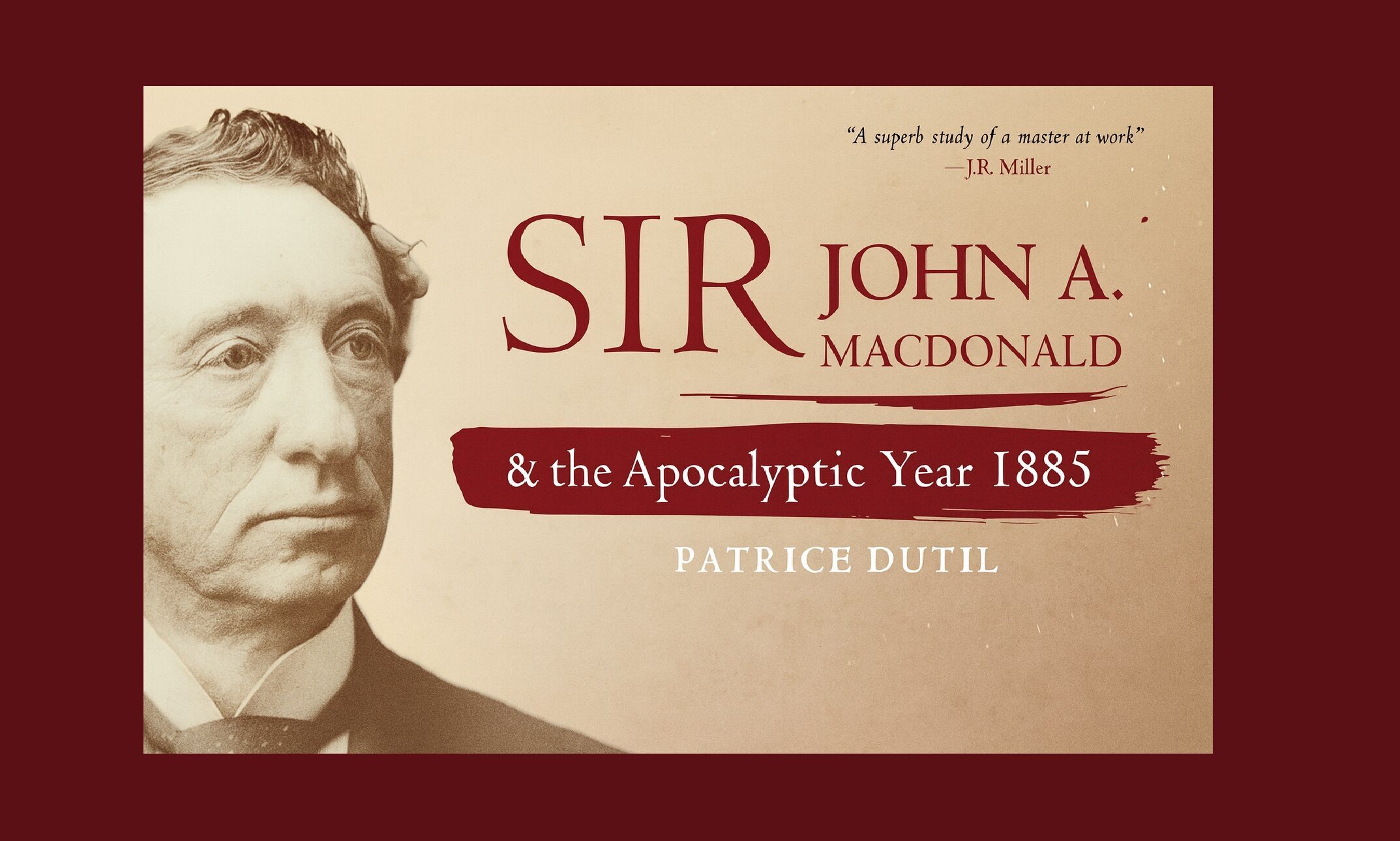

One could contend that a brief skirmish gone wrong on a snowy field near Duck Lake, in present-day central Saskatchewan, helped Canada become a country. This momentous, yet little-known, episode in our history is insightfully chronicled in the book “Sir John A. Macdonald & the Apocalyptic Year 1885” by Patrice Dutil (Sutherland House), a professor at Toronto Metropolitan University.
March 26, 1885:
The word apocalyptic in the book’s title is striking. As armed hostilities go, a brief—albeit deadly—clash on a remote field some 2,900 kilometres west of Ottawa might not ignite popular passions. But when news of the death of Crozier’s men was telegraphed to the Macdonald government, and hence bruited to newspapers across Eastern Canada, the reaction was, well, apocalyptic.
Subsequent hostilities that sprang up between government militia and Métis/Cree forces—at Fish Creek, Frenchman’s Butte, Batoche, and Loon Lake—exacerbated that reaction. Writes Dutil: “News of the attacks on government troops hit central Canada like lightning, and it took a remarkably short time to organize a response.”
Battalions and regiments from Toronto, Montreal, Ottawa, Kingston, and Quebec were quickly mobilized for deployment to counter the resistance and, within a few days, were westbound on still-incomplete sections of the Canadian Pacific Railway. Where necessary, the men plodded and portaged across frozen landscape and arrived in Winnipeg a week later, bone-tired from the gruelling trek. There, some 3,000 more men volunteered and on April 11, they set out to counter Riel and Dumont.
Besides the near-unanimous response in central Canada to the Métis/Cree assaults on government forces, the clashes injected new life into the need for completing the CPR. Dutil closely recounts how both Macdonald and CPR president George Stephen had come close to exhausting every means they could think of to acquire funding for the railway they knew was vital to unify the country.
Macdonald, battling the Liberals’ unrelenting opposition, leveraged government and monetary grants so as to issue bonds in London and New York; achieved government-guaranteed loans from the Bank of Montreal; secured support from a consortium of businessmen in exchange for a large government credit and land grant; and offered property tax exemptions to the CPR for 20 years. At one point, Stephen and a few others put up their own personal property as collateral on bank loans, while Macdonald managed to secure a $250,000 loan from a bank in Scotland.
But in March 1885, such were the mounting costs, including a construction camp strike in British Columbia and an untimely recession, that both Macdonald and Stephen were set to let the CPR go into receivership and leave the railway forever unfinished.
Then, on March 26, came the electrifying news of the Duck Lake deaths of Crozier’s 12 men. Writes Dutil: “The fate of the CPR changed within minutes as news of the confrontation at Duck Lake reached Ottawa. … Public opinion suddenly turned in favour of the CPR.”
As a result, financial backing loosened enough to keep the cause alive, chiefly through the government’s securing of the entire value of the CPR in exchange for buying $35 million of its bonds, and an agreement from Baring Brothers of London to sell CPR bonds. Various obstacles remained, but the CPR juggernaut prevailed and the ceremonial “last spike” of the railway was driven on Nov. 7, 1885, at Craigellachie, near the Eagle Pass summit in B.C.
So there you have it: an incredible achievement led by a brilliant politician whose vision of a railway-unified country compelled him to overcome prodigious impediments. Clearly, Macdonald should be universally known as “Mr. Canada,” or some such moniker. He’s this country’s Abraham Lincoln or George Washington.
But the post-modern ideology that took root across North America in the late 1960s has broadly succeeded in demonizing the Father of our Confederation. Many slander him as a racist, a colonialist, a prototypical Nazi, and no less than a committer of genocide.
They’ve succeeded in downing many statues of him, de-naming schools in his honour, and shaming him in the minds of our schoolchildren. Recently, Saskatoon’s city council voted to change its four-kilometre John A. Macdonald Drive to “Miyô-wâhkohtowin Road” (“good relationship” in Cree). Meanwhile, a striking sculpture of a mounted Gabriel Dumont graces a downtown park. The student centre on the University of Saskatchewan campus is named “Place Riel.”
Throughout his book, Dutil adroitly addresses the dark imputations against his subject. For example, he reminds the reader that attendance at the “well-intentioned” but now-infamous residential schools was very “patchy” and their success at assimilating the young attendees was poor.
As for the alleged genocide within residential schools, the seasoned contributors to the 2023 book “Grave Error: How the Media Misled Us and the Truth About Residential Schools” repeatedly debunk the claim. Dutil himself effectively cross-examines a number of claims on the topic, noting that it was periods of illness and/or hunger that caused large numbers of indigenous deaths, not intentional genocide.
Concerning the charge of treason against Riel and his Nov. 16, 1885, hanging in Regina, Dutil notes that Macdonald subscribed to the French notion of “raison d’état, the political principle that places the interests of the state ahead of the interests of individuals and particular groups. … In this light, the government’s reaction to Riel’s direct challenge in 1885 was entirely predictable. The vast majority of Canadians believed that the government had acted properly with regard to Riel.”
Also, Macdonald’s detractors should not forget that, through the 1870s and 1880s, his government ran a successful national program to vaccinate every indigenous Canadian against smallpox. When the vital buffalo population collapsed, he implemented a massive five-year famine-relief program that saved many thousands of indigenous lives. He negotiated treaty rights before white settlement began. He created the NWMP, mainly to deter violent incursions from the United States. He advocated for the suffrage of women and achieved voting rights for Indigenous men who made at least $300 a year.
Interestingly, notes Dutil, Prime Minister Pierre Trudeau regarded himself as a “John A. Macdonald Conservative” at heart. Trudeau spoke of how he admired the Métis’ fighting spirit, but ultimately endorsed Macdonald’s response to the situation, noting that “the economic and political momentum of the two young countries that shared this continent was too great to justify or permit further fragmentation.”
Dutil acknowledges that, over the course of his 50 years in politics, Macdonald did occasionally mouth offensive remarks about other ethnic groups. However, “in all cases, they can be offset by positive remarks he made regarding the same groups, not to mention slighting remarks he made against white settlers.” Indeed, he adds, “Macdonald was routinely upset about the intolerance of white settlers towards Indigenous peoples and about white labourers protesting Chinese immigration.” Also, the vast majority of 19th-century Canadians flung ethnic epithets about with abandon: “Social discourse was rife with racial assumptions and stereotypes, much of it rooted in folklore and pseudo-science.”
Dutil’s 33 pages of after-text notes are very thorough. I do have one criticism—the index. For example, “Duck Lake” is missing, as is “Queen Victoria” (who knighted Macdonald on July 1, 1867, for his pivotal role in Confederation). Residential schools are discussed in numerous places in the book, but the index refers to only two pages on that topic. Such laxity can leave you searching for a passage you know is there somewhere.
That caveat aside, one hopes that Dutil’s book will help restore the reputation of Macdonald as a man of principle, vision, and pre-eminence.
Hon. Bronwyn Eyre, LLB, is a senior fellow with the Aristotle Foundation for Public Policy, Saskatchewan’s former Minister of Justice and Attorney General—the first woman to hold each position—and a former long-serving Minister of Energy.
Like our work? Think more Canadians should see the facts? Please consider making a donation to the Aristotle Foundation.
SUBSCRIBE TO OUR NEWSLETTER
